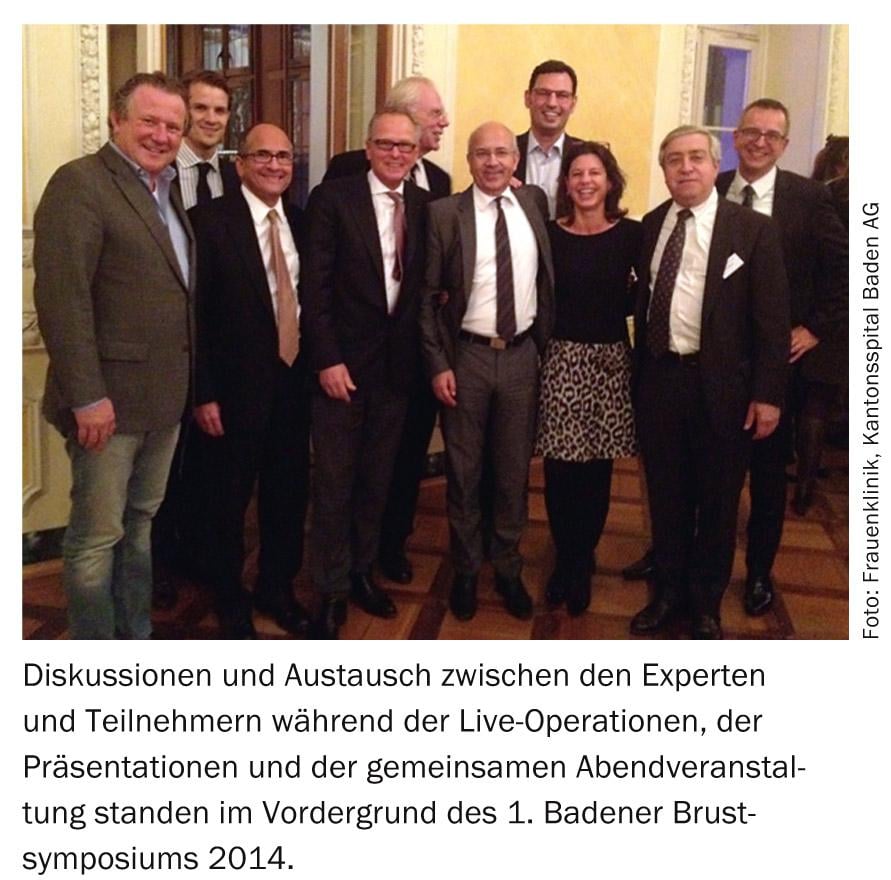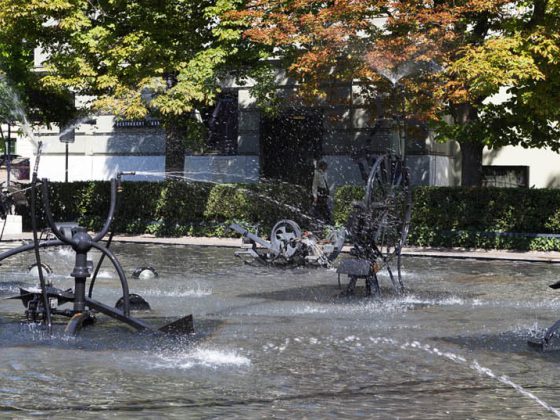At 7. and November 8, 2014, the 1st Baden Breast Symposium took place at the Women’s Clinic of the Cantonal Hospital Baden. The focus of the conference, which was organized under the direction of PD Nik Hauser, MD, and Holger Dieterich, MD, was plastic reconstructive breast surgery.
With the possibilities of oncoplastic surgery, a good 70% of women with breast carcinoma can nowadays be operated on in a breast-conserving manner. However, a not insignificant proportion of women continue to face the need for mastectomy in addition to a diagnosis of breast cancer. Every affected woman should be informed about the options of immediate or late reconstruction before a planned mastectomy.

The symposium opened with a live surgery session. The participants had the opportunity to discuss with the surgeons in the lecture hall via direct connection to two operating rooms and to ask questions about the operations performed. Mahdi Rezai, MD, Düsseldorf, operated on a secondary reconstruction using TRAM flap, and in the second operating room, a bilateral skin-sparing mastectomy with immediate reconstruction using silicone implant insertion with additional use of synthetic mesh was demonstrated by a surgical team from the Baden Breast Center (Fig. 1) . In addition, an approximating augmentation as well as a mammareductionplasty after breast cancer surgery were demonstrated. Indications as well as different options and techniques were presented by the presenters and discussed with the audience.

Oncoplastic and reconstructive breast surgery
In his Keynote Lecture, Prof. Sumner Slavin, MD, Harvard Medical School, Boston, summarized the most important aspects of oncoplastic and reconstructive breast surgery. He also reported on his many years of experience in the application of free flap techniques and went into detail about the special features: These include selecting the appropriate technique for each patient and the very specialized and intensive training required to learn and appropriately apply microsurgical surgical techniques.
The following sessions dealt in detail with the various aspects of implant surgery and tissue replacement by autologous tissue transfer.
Prof. Dr. med. Andreas Günthert, Lucerne, opened the first series of lectures with an exciting and provocative lecture on the indications and possible forms of mastectomy. Prof. Dr. med. André Faridi from Berlin reported on his experience with immediate reconstruction using silicone implants. The use of acellular dermal matrices (such as Strattice®, available in Switzerland, or Epiflex®, commonly used in Germany) or synthetic meshes (e.g. TiloopBra®) has optimized the possibilities of immediate reconstruction after skin-sparing or mammilla-preserving mastectomy. Taking into account appropriate tumor biology characteristics and patient anatomy, these methods lead to high patient satisfaction without compromising oncologic safety. However, the question of when which network or matrix should be used preferentially remains unanswered at present, as the data available on this subject is still insufficient.
Prof. Peter Cordeiro, MD, Memorial Sloan Kettering Cancer Center, New York, and Prof. Faridi then presented on the advantages and disadvantages of “one-stage” vs. “two-stage” reconstructions. In a large case series, Prof. Cordeiro showed his experience with his preferred “two-stage” reconstruction using tissue expanders with subsequent change to the definitive implant. With this technique, the use of meshes or matrices is usually not necessary.
Radiotherapy and autologous tissue transfer
An educational block was also devoted to the issue of radiotherapy before or after reconstruction. Under the moderation of Prof. Cordeiro and Prof. Werner Lichtenegger, MD, Berlin, many aspects were discussed by Prof. Stephan Bodis, MD, Aarau.
An exciting discussion also arose under the moderation of Dr. Dieterich around the topic of autologous tissue transfer: advantages and disadvantages of free and pedicled flaps. Prof. Pietro Giovanoli, MD, Zurich, and Prof. Slavin summarized the advantages of free flap techniques. These were contrasted with the experiences of Stephanie Buchen, MD, Pforzheim, Germany, and Dr. Rezai, MD, who spoke on pedicled flap techniques. Both of these sophisticated techniques produce cosmetically pleasing and long-lasting results. The decision-making process must include the patient’s wishes and the surgeon’s expertise. Reconstructions should be reserved for centers with an appropriately high number of cases per year.
Adjuvant/neoadjuvant systemic therapies and lipotransfer.
On the second day of the symposium, current aspects of adjuvant and neoadjuvant system therapies were discussed under the moderation of Prof. Hans-Jörg Senn, St. Gallen, MD, and Prof. Daniel Fink, Zurich, MD. In particular, the presentation of basic principles and study results on neoadjuvant therapy, presented by Prof. Jens Huober, Ulm, MD, and the data situation on gene expression analyses, presented by Patrizia Sager, Bern, MD, should be mentioned here.
Finally, Daniela Rezek, MD, Wesel, MD, Max Dieterich, Rostock, MD, and Prof. Cordeiro discussed the indications and techniques of lipotransfer. Overall, caution is advised in the use of lipofilling after breast cancer surgery, as the question of oncological safety, especially when used after breast-conserving therapies, has not yet been conclusively answered.
The 1st Baden Breast Symposium brought together top-class national and international experts who jointly presented and discussed current standards and developments in the field of plastic-reconstructive breast surgery – a successful event that went into depth and thrived on joint discourse.
PD Cornelia Leo, MD
PD Dr. Nik Hauser
InFo ONCOLOGY & HEMATOLOGY 2014; 2(10): 24-26.











